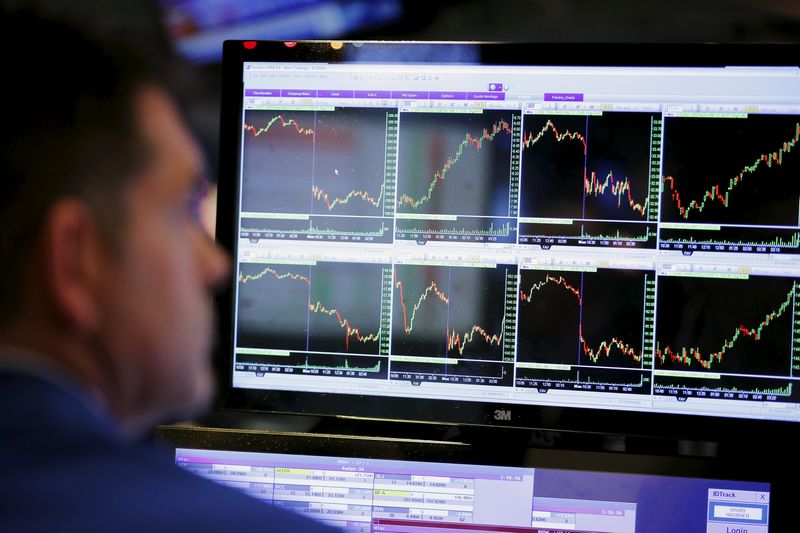By Geoffrey Smith
Investing.com — The U.S. releases more labor market data into a market increasingly focused on recession risks. Ukraine opens the door ever so slightly to a negotiated peace settlement with Russia. The ECB is still on course to hike again in May, but India surprisingly keeps its key rate unchanged. Here’s what’s moving financial markets on Thursday, 6th April.
1. Labor market data drip-feed continues
The steady stream of U.S. labor market data continues with the release of weekly jobless claims and the Challenger Gray job cuts report for March. , due at 08:30 ET (12:30 GMT) are set to touch 200,000 for what would be only the second time since early January.
The March survey and report both indicated that the labor market is cooling quickly, albeit from red-hot levels.
That has encouraged market participants to bet more heavily on a lower interest rate trajectory going forward: the yield has now fallen for five days straight, shrugging off repeated interventions from senior Federal Reserve officials who still want to raise the fed funds target range further and hold it there for an extended period.
2. Ukraine hints at peace talks as Macron, von der Leyen meet Xi
Ukraine indicated that it’s willing – with conditions – to negotiate with Russia over the future of Crimea, the first softening of its official position in months. The shift creates a glimmer of hope over how to end a conflict that has badly disrupted the global economy and global markets over the last year.
Andriy Sybiha, the deputy head of Ukrainian President Volodymyr Zelensky’s office, told the FT that Ukraine would be prepared to talk if its troops reached the neck of the isthmus connecting Crimea to the rest of the country, an apparent acknowledgment that it doesn’t have the military strength to achieve full reunification.
The comments come on a day that EU Commission President Ursula von der Leyen and French President Emmanuel Macron are in Beijing for talks with President Xi Jinping. While those talks are likely to concentrate on the worsening economic relations between the two blocs, they are also likely to touch on China’s support for Russia in the war, and its recent proposals for ending the war.
3. Stocks drifting lower in thin markets, with focus on recession risks
U.S. stock markets are in a holding pattern, with absences due to the looming Easter and Passover holidays likely to keep many on the sidelines – at least until Friday’s official labor market report.
By 05:30 ET (9:30 GMT), were down 6 points, effectively unchanged, while were down less than 0.1% and were down 0.2%. The three main cash indices were mixed on Wednesday, with the Nasdaq losing over 1% on fears of a recession, while the Dow held up better.
Stocks in focus later are likely to include Costco (NASDAQ:), which fell 2.0% in premarket after disappointing sales figures for March.
Constellation Brands (NYSE:), the brewer of Corona, is due to report earnings before the open, while Levi Strauss (NYSE:) updates after the close.
4. ECB on course to hike as German data surprises again; India keeps on hold
The European Central Bank is still on course to raise again at its next meeting, according to its chief economist Philip Lane. Lane said that if the economy turns out as the bank forecasts, another hike will be appropriate when the governing council meets on May 4th.
His comments followed a stronger-than-expected rise in German for February, which combined with strong data on Wednesday put the Eurozone economy on course to avoid recession in the first quarter.
Other economic data overnight also surprised to the upside, with China’s hitting its highest in nearly three years. U.K. also notched an 0.8% gain in March, bolstering expectations that the Bank of England will raise again.
The day’s big interest rate decision, however, was a surprise in the other direction, with India keeping its key rate , rather than hiking by 25 basis points, as expected.
5. Oil consolidates after OPEC-driven rally; ruble hits 12-month low as sanctions bite
Crude oil prices drifted lower, having apparently fully priced in OPEC’s surprise production cuts at the weekend and a surprisingly large drop in U.S. inventories last week.
By 06:20 ET, futures were down 0.1% at $80.53 a barrel, while was down 0.1% at $84.94 a barrel.
The weakness of oil prices over the first two months of the year was evident on Wednesday as Russia announced its oil and gas revenue fell 43% from a year earlier in March. The news helped push the to a 12-month low against the dollar on Thursday.
Read the full article here








